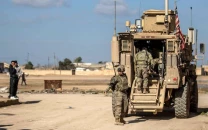North Korea sends balloons carrying excrement to the south as a 'gift'
DPRK says balloons are retaliation for propaganda campaign by North Korean defectors and South Korean activists

North Korea sent hundreds of balloons carrying trash and excrement across the heavily fortified border to South Korea on Wednesday, calling them "gifts of sincerity", prompting an angry response from Seoul, which said the act was base and dangerous.
Photographs released by the South Korean military showed inflated balloons with plastic bags tied to them. Other images appeared to show trash strewn around collapsed balloons, with the word "excrement" written on a bag in one photograph.
By Wednesday afternoon, more than 260 balloons had been detected, and most of them have landed on the ground, carrying animal faeces and rubbish, the South Korean military said in a statement, calling the act "base and dangerous".
Read also: North Korea to deploy new 240mm multiple rocket launcher system
North Korea said the balloons were in retaliation for an ongoing propaganda campaign by North Korean defectors and activists in South Korea, who regularly send inflatables containing anti-Pyongyang leaflets, alongside food, medicine, money and USB sticks loaded with K-pop music videos and dramas across the border.
Kim Yo Jong, North Korean leader Kim Jong Un's sister and a powerful ruling party official, issued a statement in state media KCNA, slamming Seoul as "shameful, brazen" for criticising the balloons while defending its citizens' own freedom of expression.
The North's balloons were "gifts of sincerity" for South Koreans who "cry for freedom of expression", she said, pledging to send dozens of times the number she said South Korea had sent into its territory.
An official at Seoul's presidential office said the North might want to "test" the South's reaction but vowed to respond calmly.
Psychological warfare
"By putting rubbish and miscellaneous objects into balloons, they seem to want to test how our people would react and whether our government is indeed disrupted, and apart from direct provocations, how psychological warfare and small-scale complex threats would play out in our country," the official told reporters.
The South Korean military's explosives ordnance unit and chemical and biological warfare response team were deployed to inspect and collect the objects, and an alert was issued warning residents to keep away and report any sightings to authorities.
On Sunday, North Korea's vice defence minister denounced balloons sent by South Korean activists, calling them "dirty things" and a "dangerous provocation," and warned that "mounds of waste-paper and filth" would be sent to the South in response.
North Korea also attempted to jam GPS signals in South Korea on early Wednesday morning, although no damage was reported, the Donga Ilbo newspaper said, citing multiple unnamed government sources.
Seoul's defence ministry said it had no immediate comment on the report.
A previous South Korean government sought to block such campaigns, especially after a 2014 incident when the North tried to shoot down balloons, which triggered complaints from residents near the border.
A ban on balloon launches introduced in 2021 was later ruled unconstitutional by a top court, which said it violated freedom of speech.
The two Koreas' large militaries face off across the military border and North Korea routinely threatens to annihilate its neighbour.
Peter Ward, a research fellow at the Sejong Institute, said sending balloons was a far less risky than taking overt military action.
"These kinds of grey zone tactics are more difficult to counter and hold less risk of uncontrollable military escalation, even if they're horrid for the civilians who are ultimately targeted," he said.



1701351241-1/Afghan-refugees-(3)1701351241-1-208x130.webp)















COMMENTS
Comments are moderated and generally will be posted if they are on-topic and not abusive.
For more information, please see our Comments FAQ